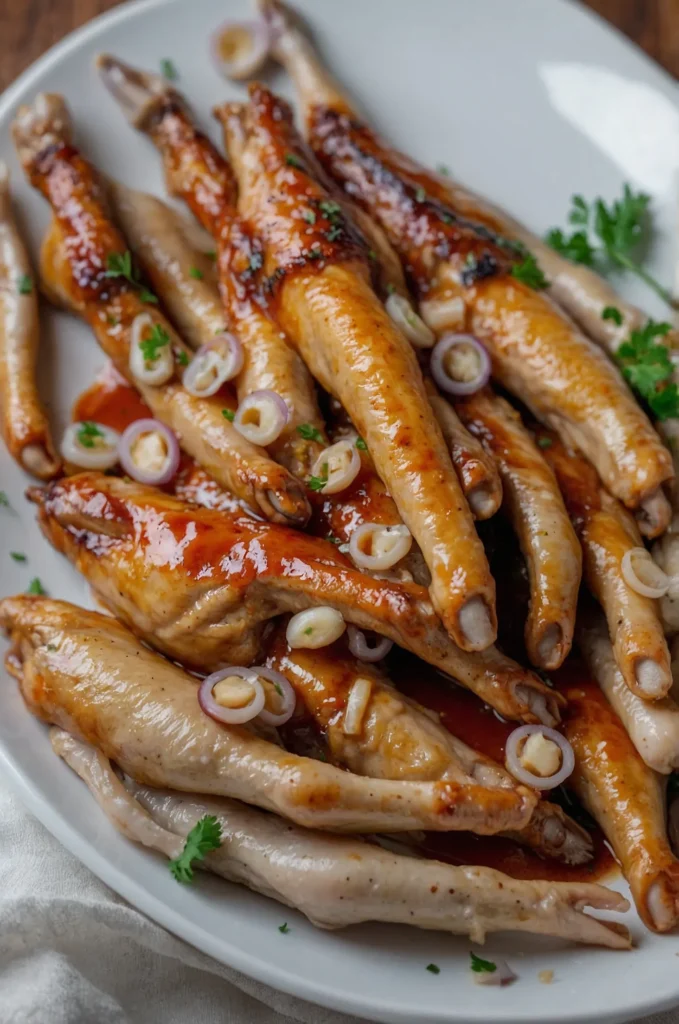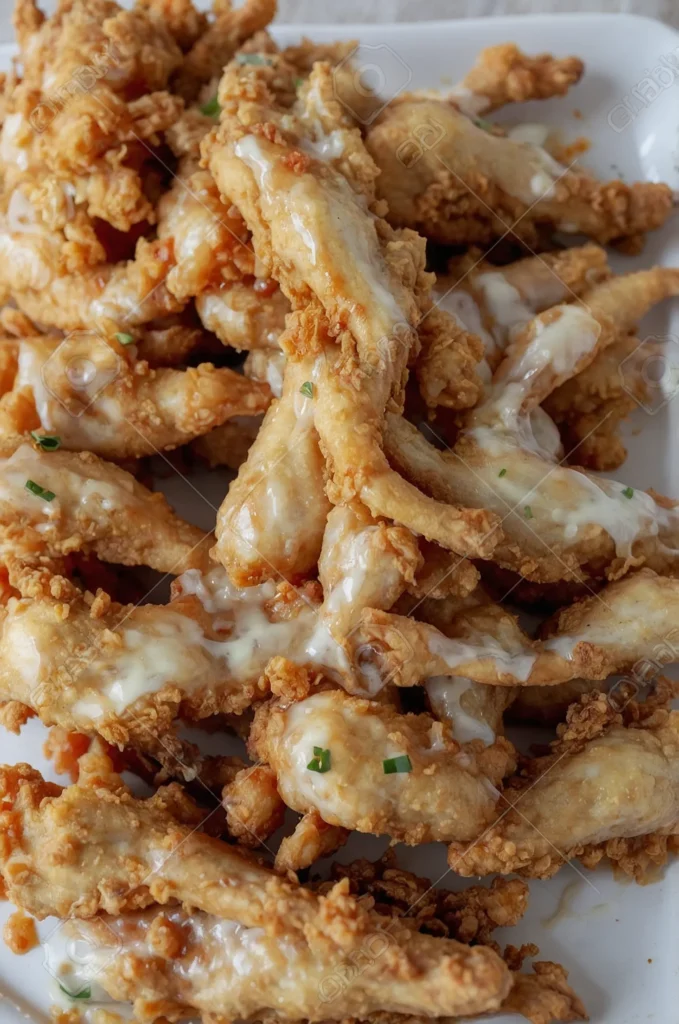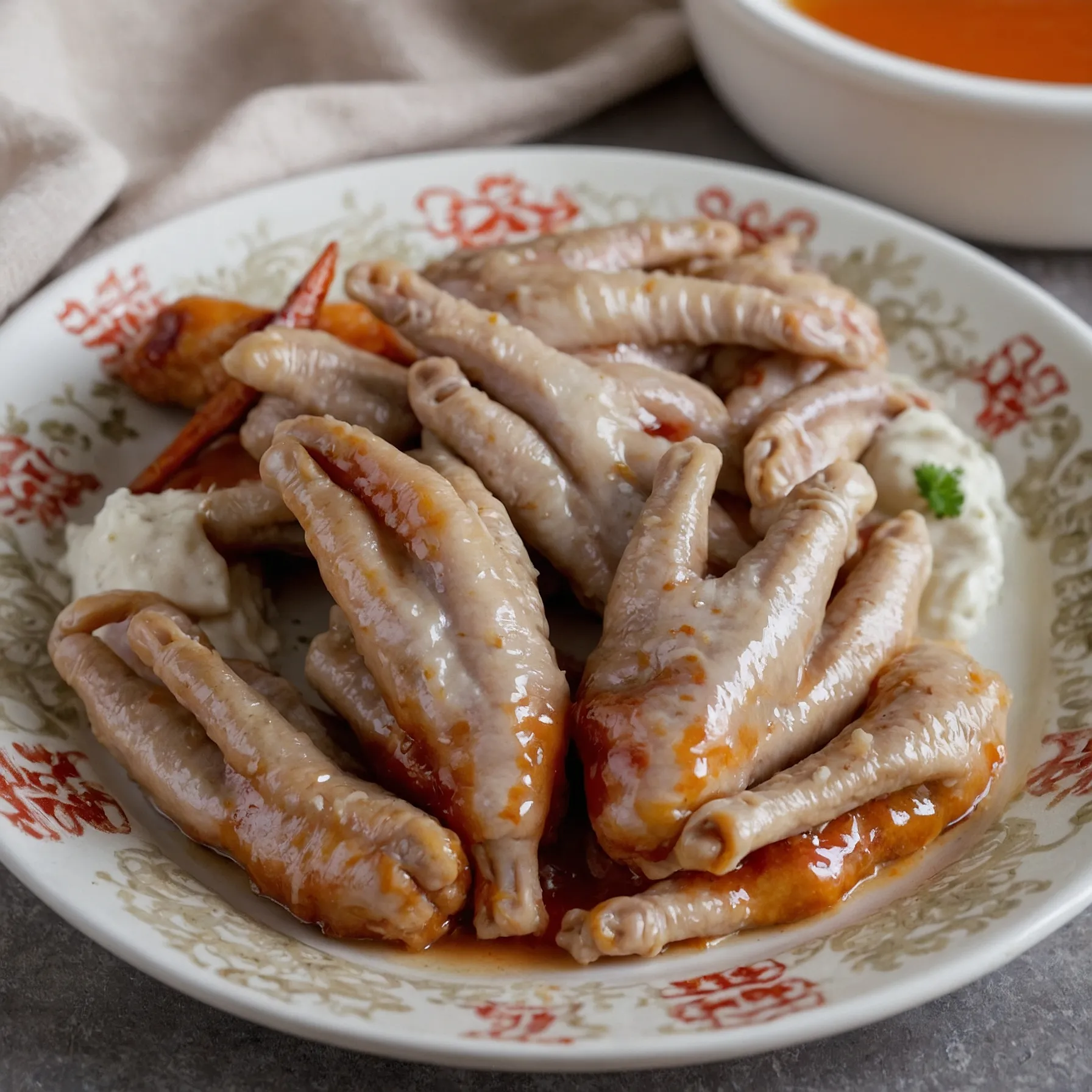Chicken Paws: Irresistibly Flavorful Recipes for a Delicious Meal
Discover everything about chicken paws: nutrition benefits, cleaning tips, cooking methods, and delicious recipes for this collagen-rich delicacy.
Are you searching for the best chicken paws recipe or curious about how to prepare homemade chicken paws? You’ve come to the right place! Whether you’re a culinary adventurer looking to explore new flavors or someone interested in traditional dishes from around the world, chicken Feet (also known as chicken feet) offer a unique and rewarding culinary experience.
In this comprehensive guide, we’ll walk you through everything you need to know about chicken paws—from what they are and their impressive nutritional benefits to how to clean, prepare, and cook them using various methods. We’ll also share essential tips for perfect results every time and answer the most common questions people have about this unique ingredient.
As passionate home cooks who’ve perfected dozens of chicken Feet recipes over the years, we’re excited to share our expertise and help you discover why these underappreciated parts deserve a place in your culinary repertoire.
Content Overview
Table of Contents
What Exactly Are Chicken Paws/Feet?
First things first: what’s the difference between chicken paws and chicken feet? In culinary terms, they’re essentially the same thing, though “paws” is sometimes used as a more appealing marketing term in grocery stores or on restaurant menus. The term “paws” likely gained popularity because of the visual similarity to animal paws, with their padded appearance.
Anatomically speaking, chicken paws consist primarily of:
- Skin
- Tendons
- Cartilage
- Small bones
- Minimal meat
One common misconception is that chicken paws are “just bones” with no culinary value. In reality, they’re prized in many cuisines precisely because of their unique composition. The high concentration of connective tissue, when cooked properly, transforms into rich gelatin that creates distinctive textures and deeply flavored broths.
Discover more Chicken Recipes
The Allure: Why Eat Chicken Paws?
Nutritional Deep Dive
Chicken paws are nutritional powerhouses, particularly when it comes to collagen content. Let’s break down what makes them so special from a nutritional perspective:
Collagen Content
Chicken paws contain primarily Type II collagen, which is particularly beneficial for joint health. While many collagen supplements are derived from bovine sources (primarily Type I collagen), the Type II collagen found in chicken paws has shown specific benefits for cartilage support.
Research suggests that the collagen in chicken paws has excellent bioavailability, meaning your body can effectively absorb and utilize it. A single serving of properly prepared chicken paws (about 100g) can provide approximately 10-12g of collagen.
Key Nutrients in Chicken Feet
| Nutrient | Amount per 100g | Benefits |
|---|---|---|
| Protein | 19-22g | Muscle maintenance, satiety |
| Collagen | 10-12g | Skin elasticity, joint health |
| Hyaluronic Acid | Present (varies) | Skin hydration, joint lubrication |
| Chondroitin Sulfate | Present (varies) | Joint support, anti-inflammatory |
| Calcium | 88mg | Bone health |
| Phosphorous | 69mg | Energy metabolism, bone health |
| Calories | Approximately 150-215 | Lower than many meat cuts |
When compared to other chicken parts, paws have significantly higher collagen content but lower overall fat and calories than skin-on chicken thighs or wings.
Taste & Texture Profile
Let’s be honest about what to expect when eating chicken paws:
The texture is what makes chicken paws unique. They have a gelatinous, slightly chewy consistency that’s unlike any other part of the chicken. This distinctive texture comes from the high collagen content, which transforms during cooking.
Flavor-wise, chicken paws themselves have a mild chicken flavor, but they excel at absorbing the flavors of whatever they’re cooked with. This makes them perfect for dishes with bold sauces or aromatic broths.
For first-timers, the texture can be surprising, but many people find it becomes an acquired taste they grow to crave. If you enjoy other gelatinous foods like oxtail or pork belly, you’ll likely appreciate the texture of well-prepared chicken paws.
Cultural Significance
Chicken paws aren’t just nutritionally valuable—they hold important cultural significance in cuisines around the world:
- Chinese Cuisine: Featured prominently in dim sum as “Phoenix Claws” (鳳爪), typically braised with black bean sauce or other flavorful combinations.
- Filipino Cooking: Used in Adidas (a playful name for chicken feet dishes) or simmered in adobo sauce.
- Jamaican Cuisine: Key ingredient in hearty, flavorful chicken foot soup.
- Southern United States: Sometimes prepared pickled or in soups and stews.
- South African Cuisine: Known as “walkie talkies” when prepared with chicken heads.
These diverse preparations demonstrate how cultures around the world have recognized the value in this often-overlooked part.
Sourcing & Selection: Finding the Best Chicken Paws
Where to Buy Chicken Paws
Finding high-quality chicken paws might require a bit more effort than picking up other chicken parts, but good sources include:
- Asian Markets: Often have the freshest selection and best prices, as chicken paws are popular in many Asian cuisines.
- Specialty Butchers: May carry them or can order them specifically for you with advance notice.
- Farmers’ Markets: Local poultry farmers sometimes offer them, especially those focusing on whole-animal butchery.
- Online Specialty Food Retailers: Increasingly, you can find frozen chicken paws through online meat delivery services.
- Some Mainstream Grocery Stores: Check the poultry section or ask at the meat counter.
The quality can vary significantly between sources. Freshly processed local chicken paws will typically offer better flavor and texture than mass-produced frozen options, but both can yield excellent results with proper preparation.
Quality Check: What to Look For
Whether buying fresh or frozen chicken paws, here’s how to select the best quality:
Fresh Chicken Paws Should:
- Have plump, intact skin
- Appear clean with a pale yellow to pinkish color
- Feel firm and not slimy
- Has no strong odor beyond a mild poultry smell
Frozen Chicken Paws Should:
- Show no signs of freezer burn
- Have minimal ice crystals inside the packaging (excessive ice suggests thawing and refreezing)
- Appear individually frozen rather than clumped (indicates proper freezing methods)
Avoid Chicken Paws That:
- Have a strong ammonia or sour smell
- Show discoloration (particularly dark spots)
- Have broken or damaged skin
- Appear dehydrated or shriveled
Crucial Prep: Cleaning Chicken Paws Like a Pro
Proper cleaning is perhaps the most critical step in preparing delicious chicken paws. Follow this detailed guide for best results:
1. Thawing (If Using Frozen)
- Do: Thaw in the refrigerator overnight for the safest method
- Don’t: Thaw at room temperature, which can encourage bacterial growth
- Quick Method: If pressed for time, place sealed package in cold water, changing water every 30 minutes until thawed
2. Initial Rinse
- Rinse under cold running water to remove any visible debris
- Examine each paw for any remaining bits of yellow outer skin or calluses
3. Removing the Yellow Membrane
The outer yellow membrane can impart a bitter taste if not removed:
- Bring a pot of water to a rolling boil
- Prepare a bowl of ice water
- Blanch the paws in boiling water for 20-30 seconds
- Transfer immediately to ice water
- The yellow membrane should now peel away easily using your fingers or a small knife
4. Clipping the Nails/Talons
This step is essential for both aesthetics and eating comfort:
- Use kitchen shears or a sharp knife
- Cut just at the first joint of each toe to remove the nail
- Be decisive with your cuts to ensure clean removal
- Discard the cut nails
5. Thorough Washing
- Use a scrub brush dedicated to food preparation (a new toothbrush works well)
- Scrub between the toes and all crevices with coarse salt or baking soda
- Rinse thoroughly under cold running water
- Repeat the scrubbing if necessary until water runs clear
6. Optional: Blanching
While not essential, blanching helps improve texture and removes any remaining impurities:
- Bring a large pot of water to a boil
- Add 1 tablespoon of vinegar (helps tighten the skin)
- Add cleaned chicken paws and boil for 2 minutes
- Drain and rinse under cold water
- Pat dry with paper towels before proceeding with your recipe
This thorough cleaning process might seem labor-intensive, but it’s the secret to transforming chicken paws into a delicious ingredient worthy of your table.
Discover more Chicken Recipes
Mastering the Methods: How to Cook Chicken Paws
Now that your chicken paws are properly cleaned, let’s explore the primary cooking methods and their unique benefits:
Braising: The Classic Approach
Best for: Tender, flavorful chicken paws with a soft, gelatinous texture.
Method Overview:
- Brown paws in oil until golden (optional but adds flavor)
- Add aromatic ingredients (garlic, ginger, onions, etc.)
- Pour in cooking liquid (broth, soy sauce, wine, etc.)
- Simmer covered for 1.5-2 hours until tender
Pros:
- Develops deep flavor
- Creates tender, fall-off-the-bone texture
- Versatile with different sauce profiles
Cons:
- Time-consuming
- Requires attention to liquid levels
Deep-frying: For Crispy Texture
Best for: Crispy exterior with tender interior.
Method Overview:
- Par-boil paws for 5-10 minutes until partially cooked
- Dry thoroughly
- Coat in seasoned flour, batter, or leave plain
- Fry at 350°F (175°C) until golden brown and crispy
Pros:
- Creates contrasting textures
- Quick cooking time after initial preparation
- Popular as an appetizer or snack
Cons:
- Higher fat content
- Requires careful temperature monitoring
Simmering (for Stock/Broth)
Best for: Extracting maximum nutrients and flavor for soups or as a cooking base.
Method Overview:
- Place cleaned paws in a large pot with aromatics
- Cover with cold water
- Bring to a gentle simmer (not a rolling boil)
- Simmer for 3-6 hours, skimming occasionally
- Strain and use liquid as a nutritious broth
Pros:
- Maximizes collagen extraction
- Creates gelatin-rich broth
- Can be frozen for future use
Cons:
- Long cooking time
- Requires straining
Steaming: Light and Clean Method
Best for: Preserving natural flavor and preparing for further seasoning.
Method Overview:
- Arrange paws in steamer basket
- Steam over boiling water for 30-45 minutes until tender
- Season after cooking or transfer to another preparation
Pros:
- Clean, pure flavor
- Retains nutrients
- Requires minimal supervision
Cons:
- Less flavor development than braising
Core Chicken Paws Recipes
Here are three fundamental ways to prepare chicken paws that showcase their versatility:
1. Dim Sum Style Braised Chicken Paws
This classic preparation combines savory, sweet, and umami flavors with the distinctive texture of tender chicken paws.

Ingredients:
- 1 lb (450g) cleaned chicken paws
- 3 tablespoons black bean sauce
- 2 tablespoons soy sauce
- 1 tablespoon oyster sauce
- 1 tablespoon Chinese rice wine or dry sherry
- 2 teaspoons sugar
- 3 cloves garlic, minced
- 1-inch piece of ginger, sliced
- 2-3 dried red chilies (optional)
- 2 star anise
- 1 cup chicken broth
- 1 tablespoon cornstarch mixed with 2 tablespoons water
Method:
- Heat oil in a wok or deep pan over medium-high heat
- Add garlic, ginger, and dried chilies, stir-fry for 30 seconds
- Add chicken paws and brown slightly on all sides (about 2-3 minutes)
- Add black bean sauce, soy sauce, oyster sauce, rice wine, sugar, and star anise
- Pour in chicken broth, bring to a boil, then reduce to a simmer
- Cover and simmer for 1.5 hours, or until paws are tender
- Uncover, increase heat to medium-high
- Add cornstarch slurry and stir until sauce thickens
- Serve hot as an appetizer or with rice
2. Crispy Fried Chicken Paws
This preparation creates a wonderful textural contrast between crispy exterior and tender interior.

Ingredients:
- 1 lb (450g) cleaned chicken paws
- 2 cups water
- 1/4 cup rice vinegar
- 1 tablespoon salt
- 1 teaspoon baking soda
- 1 cup all-purpose flour
- 2 tablespoons cornstarch
- 1 teaspoon garlic powder
- 1 teaspoon onion powder
- 1/2 teaspoon black pepper
- Oil for deep frying
- Dipping sauce of choice
Method:
- In a pot, combine water, vinegar, salt, and baking soda
- Add chicken paws and bring to a boil
- Reduce heat and simmer for 10 minutes
- Drain and pat completely dry
- Mix flour, cornstarch, and seasonings in a bowl
- Coat paws thoroughly in the mixture
- Heat oil to 350°F (175°C)
- Fry in batches until golden brown and crispy (about 5-7 minutes)
- Drain on paper towels and serve with dipping sauce
Discover more Chicken Recipes
3. Collagen-Rich Chicken Paw Broth
This nutritious broth can be used as a base for soups or sipped on its own as a health tonic.
Ingredients:
- 2 lbs (900g) cleaned chicken paws
- 1 onion, quartered
- 2 carrots, roughly chopped
- 2 celery stalks, roughly chopped
- 4 garlic cloves, smashed
- 2-inch piece of ginger, sliced
- 1 tablespoon apple cider vinegar
- 1 teaspoon black peppercorns
- 2 bay leaves
- 10 cups cold water
- Salt to taste
Method:
- Place all ingredients except salt in a large stockpot
- Cover with cold water by about 1 inch
- Bring to a gentle simmer over medium heat
- Reduce heat to low, skim any foam that rises to the surface
- Simmer gently for 4-6 hours, adding water if needed to keep paws covered
- Strain through a fine-mesh strainer
- Add salt to taste
- Cool completely before refrigerating
- Once chilled, remove any solidified fat from the surface
- Store in refrigerator for up to 5 days or freeze for up to 3 months
Essential Tips for Perfect Chicken Paws
Flavor Pairings
Chicken paws work exceptionally well with these flavor combinations:
- Asian-inspired: Soy sauce, ginger, garlic, star anise, five-spice powder
- Latin American: Cilantro, lime, achiote, cumin, chili peppers
- European: White wine, garlic, thyme, bay leaf, mirepoix
- Middle Eastern: Turmeric, cinnamon, coriander, lemon, tomato
Common Mistakes to Avoid
- Inadequate cleaning: This is the number one reason for unpleasant results. Never skip the cleaning process.
- Undercooking: Chicken paws need sufficient time to become tender. Rushing the process results in a tough, unpleasant texture.
- Overcrowding the cooking vessel: Give them space in the pot or pan for even cooking.
- Boiling rather than simmering: A gentle simmer yields more gelatin extraction and better texture.
- Skipping the blanching step: While optional, blanching improves the final texture significantly.
Make-Ahead and Storage Tips
- Cleaned Raw Paws: Store in refrigerator for 1-2 days or freeze for up to 3 months.
- Cooked Paws: Refrigerate for up to 3 days in their cooking liquid to prevent drying out.
- Freezing Cooked Paws: Store in an airtight container with cooking liquid for up to 2 months.
- Reheating: Gentle stovetop reheating works best; microwave can make the texture rubbery.
- Broth Storage: Keeps in refrigerator for 5 days or freezer for 6 months.
Chicken Paws FAQ
Are chicken paws safe to eat?
Yes, chicken paws are safe to eat when properly cleaned and fully cooked. Like any poultry product, they should be cooked to an internal temperature of at least 165°F (74°C) to kill any potential pathogens.
What do chicken paws taste like?
Chicken paws have a mild chicken flavor with a unique gelatinous texture. They don’t have much meat, so the taste comes primarily from the skin and tendons, which become tender and flavorful when properly cooked. They’re excellent at absorbing the flavors of sauces and spices they’re cooked with.
How much collagen is in chicken feet?
Chicken paws are one of the richest natural sources of collagen. A 100g serving contains approximately 10-12g of collagen, primarily Type II collagen, which is particularly beneficial for joint health. This high collagen content is what creates their distinctive texture when cooked.
Do you eat the bones in chicken feet?
No, you don’t eat the actual bones. The cooking process tenderizes the cartilage, tendons, and skin, which you do eat. The small bones are typically either removed before eating or eaten around. In dim sum preparations, experienced eaters will often take the entire piece in their mouth, work the meat off with their teeth, and discreetly remove the small bones.
How long do chicken paws take to cook?
Cooking time depends on the method:
- Braising: 1.5-2 hours
- Deep-frying: 5-7 minutes (after par-boiling)
- Simmering for broth: 3-6 hours
- Steaming: 30-45 minutes
Regardless of method, chicken paws should be cooked until tender—when properly done, the meat should easily pull away from the bones.
Conclusion: Embracing the Humble Chicken Paw
Chicken paws represent culinary resourcefulness at its finest—taking what many consider a “throwaway” part and transforming it into something delicious and nutritious. From their impressive collagen content to their ability to absorb flavors, chicken paws deserve a spot in your culinary repertoire.
Whether you’re drawn to them for their nutritional benefits, curious about experiencing traditional dishes from cultures around the world, or simply looking to expand your culinary horizons, we hope this guide has equipped you with everything you need to prepare homemade chicken paws with confidence.
Don’t be intimidated by the cleaning process—it gets easier with practice, and the results are well worth the effort. Start with our braised dim sum style recipe for an authentic introduction, or try the collagen-rich broth for a nutritious addition to your cooking base collection.
We’d love to hear about your experiences cooking chicken paws! Have you tried them before? Do you have a family recipe to share? Let us know in the comments below, and don’t forget to check out our related articles for more in-depth exploration of specific chicken paws recipes.
Note: This blog post is part of our comprehensive guide to using the whole chicken. Check out our related posts on chicken liver pâté, bone broth, and other traditionally overlooked parts for more inspiration.

